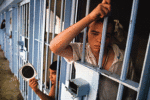
All Adults Are the Protectors of All Children
Support KARA (BUY the book INVISIBLE CHILDREN)
listen to the audiobook for free Free Weekly KARA Updates
Several states including California and Arizona have used early grade test scores to assist in forecasting required prison capacity growth. Corrections Digest, April 12, 2002 reports Federal Prisons are 131% of design capacity – 2015 18 states are over capacity.
A few years ago I presented at the 11th National Workshop on Adult & Juvenile Female Offenders held in Bloomington MN
There were wardens and justice workers from many states & many stories. America has 25% of the world’s prison population.
The Program was committed to Gender, Environment, Relationships, Services & Supervision, Socioeconomic Status, and Community for women.
I discovered committed and intellegent people trying to effect positive change within communities that are becoming more open to new approaches.
Where progressive programs are encouraged (like Shakopee Women’s Prison used to be), recidivism is greatly reduced, while in regressive communities (some states still shackle women prisoners in child birth) recidivism for women offenders is about the same it is for male offenders.
Last year, 33 states held children and juveniles with mental illness in detention centers without any charges.
In 2001, nearly 2/3 of California local law enforcement departments did not have written guidelines governing the care of children whose sole caretaker had been arrested (Marilyn Moses, article in Police Chief, Sept 2005)
In Boston, the 9 year old Arts Incentive Program found that 57% of those with criminal records who were redirected to mental-health care have not be re-arrested or involved with the courts.
In the Texas Outreach & Tracking program participants had a 65% lower re-arrest rate than kids on parole. There are many states with great programs.
Chicago’s Child-Parent Centers have served 100,000 three and four year-olds since 1967. Findings indicate that the program cut the rates of child abuse and neglect in half.
The Nurse Family Partnership in Elmira, NY, reduced incidents of child abuse by 80% and children from families not in the program had twice as many arrests by age 15.
It’s hard to believe the vast differences between communities. Some policy makers are genuinely committed to breaking the cycle of violence, abuse, and neglect that drives emotionally and mentally disturbed people into lives on the edge of society.
Other political leaders are still banging pots and screaming for more prisons and fewer resources for people struggling to succeed.
From a strictly financial perspective, investing in children to solve problems (through repeatable proven programs) is a miniscule investment compared to the twenty, thirty, and forty years these children can spend in child protection and future correctional facilities.
We must also consider the havoc they wreak on the lives of the people within our communities and the progeny that follow them into our institutions.
The speaker I followed, Susan George, PhD Associate Professor, Harris Graduate School of Public Policy, University of Chicago,completed a large study showing relationships between foster children and incarcerated mothers and a significant growth in the number of children being born to women in the system.
A tremendous cost to society of not treating children and juveniles when they are still young enough to effect change, is the exponential addition of the next generation of potentially troubled children they bring into your community. The average number of children born to women in the Illinois systems has grown from three to four (Susan George’s recent study).
Our Federal Reserve Board Chairman, Art Rolnick has proven conservatively, that investments in early childhood programs exceed other public spending in return on investment percentages.
Citizens ask, “where will get find the money” when they ought to be asking, “how are we spending our Money?”
As a long time guardian ad-Litem working with youth in the court system, I continue to see huge sums spent on counter-productive mental health treatments, poorly designed and supported residential treatment facilities & other partial attempts to deal with serious problems.
One damaged child, without proper support can develop severe and lasting mental and emotional problems that stick to them for life.
Studies on foster home children indicate that eighty percent of foster home graduates go on to lead dysfunctional lives of mental illness, drug dependency, crime, and unemployment.
Many of these children will have lived in multiple foster placements and incur very real and very costly care before they leave their foster home placements. Think of how untreated abused children impact your schools, city streets, and police departments.
Examples:
https://invisiblechildren.org/2009/02/08/mn-early-childhood-summit-speech-david-lawrence/
https://invisiblechildren.org/2005/12/17/missouri-model/
Conferences like the National Workshop on Adult & Juvenile Female Offenders, exemplify that most of the people in the system care, there are many successful programs, and perhaps most of all, sharing information is critical to success in saving our community’s children.
Let’s do more of that.
In the weeks and months to come, I will post successful and unsuccessful programs and stories that I have gathered.
Send them to me.
Have something to add? Tell us your point of view or story…
If you think someone might appreciate this information, press the share button below..



